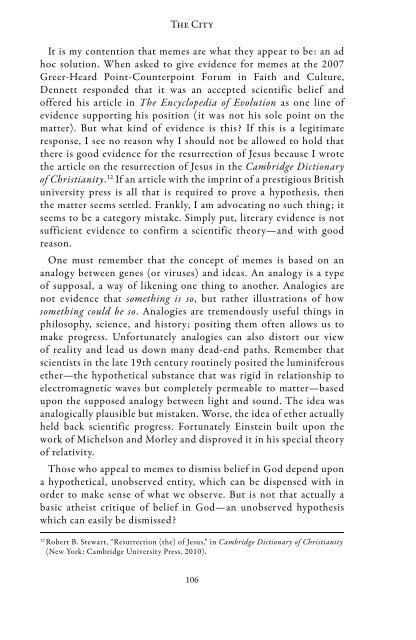THE CITY
h6c7p5d
h6c7p5d
Create successful ePaper yourself
Turn your PDF publications into a flip-book with our unique Google optimized e-Paper software.
The City<br />
It is my contention that memes are what they appear to be: an ad<br />
hoc solution. When asked to give evidence for memes at the 2007<br />
Greer-Heard Point-Counterpoint Forum in Faith and Culture,<br />
Dennett responded that it was an accepted scientific belief and<br />
offered his article in The Encyclopedia of Evolution as one line of<br />
evidence supporting his position (it was not his sole point on the<br />
matter). But what kind of evidence is this? If this is a legitimate<br />
response, I see no reason why I should not be allowed to hold that<br />
there is good evidence for the resurrection of Jesus because I wrote<br />
the article on the resurrection of Jesus in the Cambridge Dictionary<br />
of Christianity. 12 If an article with the imprint of a prestigious British<br />
university press is all that is required to prove a hypothesis, then<br />
the matter seems settled. Frankly, I am advocating no such thing; it<br />
seems to be a category mistake. Simply put, literary evidence is not<br />
sufficient evidence to confirm a scientific theory—and with good<br />
reason.<br />
One must remember that the concept of memes is based on an<br />
analogy between genes (or viruses) and ideas. An analogy is a type<br />
of supposal, a way of likening one thing to another. Analogies are<br />
not evidence that something is so, but rather illustrations of how<br />
something could be so. Analogies are tremendously useful things in<br />
philosophy, science, and history; positing them often allows us to<br />
make progress. Unfortunately analogies can also distort our view<br />
of reality and lead us down many dead-end paths. Remember that<br />
scientists in the late 19th century routinely posited the luminiferous<br />
ether—the hypothetical substance that was rigid in relationship to<br />
electromagnetic waves but completely permeable to matter—based<br />
upon the supposed analogy between light and sound. The idea was<br />
analogically plausible but mistaken. Worse, the idea of ether actually<br />
held back scientific progress. Fortunately Einstein built upon the<br />
work of Michelson and Morley and disproved it in his special theory<br />
of relativity.<br />
Those who appeal to memes to dismiss belief in God depend upon<br />
a hypothetical, unobserved entity, which can be dispensed with in<br />
order to make sense of what we observe. But is not that actually a<br />
basic atheist critique of belief in God—an unobserved hypothesis<br />
which can easily be dismissed?<br />
12<br />
Robert B. Stewart, “Resurrection (the) of Jesus,” in Cambridge Dictionary of Christianity<br />
(New York: Cambridge University Press, 2010).<br />
106


